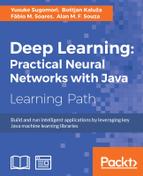We all know that humans can read and recognize images faster than any supercomputer. However, we have seen so far that neural networks show amazing capabilities of learning through data in both a supervised and an unsupervised way. In this chapter, we present an additional case of pattern recognition involving an example of optical character recognition. Neural networks can be trained to strictly recognize digits written in an image file. The topics of this chapter are:
- Pattern recognition
- Defined classes
- Undefined classes
- Neural networks in pattern recognition
- MLP
- The OCR problem
- Preprocessing and classes definition
- Implementation in Java
- Digit recognition
Patterns are a bunch of data and elements that look similar to each other, in such a way that they can occur systematically and repeat from time to time. This is a task that can be solved mainly by unsupervised learning by clustering; however, when there is labelled data or there are defined classes of data, this task can be solved by supervised methods. We, as humans, perform this task more often than we can imagine. When we see objects and recognise them as belonging to a certain class, we are indeed recognising a pattern. Also, when we analyse charts, discrete events, and time series, we might find evidence of some sequence of events that repeat systematically under certain conditions. In summary, patterns can be learned by data observations.
Examples of pattern recognition tasks include, but are not limited to:
- Shape recognition
- Object classification
- Behavior clustering
- Voice recognition
- OCR
- Chemical reaction taxonomy
In a list of classes that has been predefined for a specific domain, each class is considered to be a pattern; therefore every data record or occurrence is assigned one of these predefined classes.
One illustrated example of pattern recognition using defined classes is animal recognition by image, shown in the figure below. The pattern recogniser, however, should be trained to catch all the characteristics that formally define the classes. In the example, eight figures of animals are shown, belonging to two classes: mammals and birds. Since this is a supervised mode of learning, the neural network should be provided with a sufficient number of images to allow it to properly classify new images.

Of course, sometimes the classification may fail, mainly due to similar hidden patterns in the images that neural networks may catch and also due to small nuances present in the shapes. For example, the dolphin has flippers but it is still a mammal. Sometimes, in order to obtain a more accurate classification, it is necessary to apply preprocessing and ensure that the neural network will receive the appropriate data that will allow for classification.
When data is unlabelled and there is no predefined set of classes, it is an unsupervised learning scenario. Shape recognition is a good example, since the shapes may be flexible and have an infinite number of edges, vertices, or bindings.

In the image above, we can see some sorts of shapes and we want to arrange them, so that similar ones can be grouped into the same cluster. Based on the shape information that is present in the images, it is likely that the pattern recognizer will classify the rectangle, the square and the, triangle into the same group. However, if the information were presented to the pattern recognizer, not as an image, but as a graph with edges and vertices coordinates, the classification might change a little.
In summary, the pattern recognition task may use both supervised and unsupervised modes of learning, basically depending of the objective of recognition.
